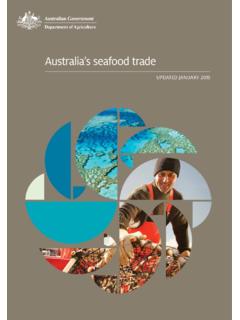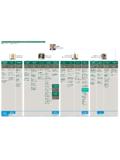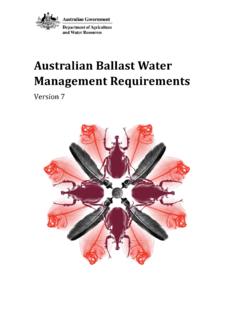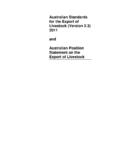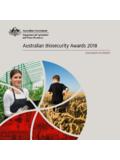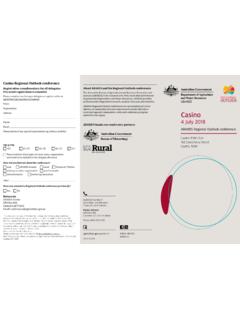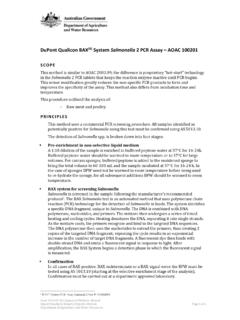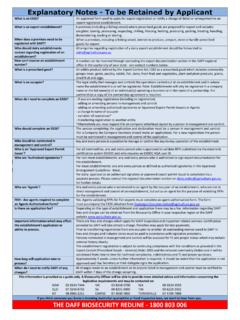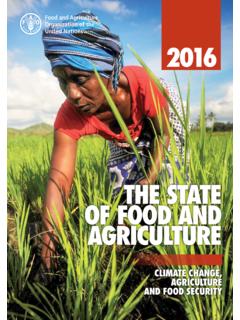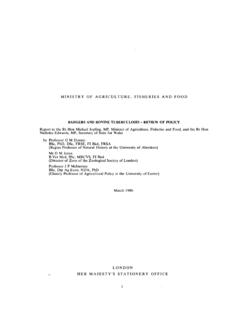Transcription of 1 Forests and Timber - Department of Agriculture …
1 1 forests and timber : A Field Guide to Exotic Pests and DiseasesAGRICULTURE, FISHERIES AND FORESTRY AUSTRALIA2 This publication has been produced by theAustralian Quarantine and Inspection Serviceand the National Office of Animal and PlantHealth, both agencies within the CommonwealthDepartment of Agriculture , Fisheries andForestry Australia, and the Ministerial Councilon Forestry, Fisheries and Aquaculture Standing Committee on material in this field guide was preparedfrom the most accurate and up to dateinformation available at the time of is intended as a guide only and the publisheraccepts no responsibility for of this publication are available at no charge from Public Relations, Australian Quarantine and Inspection Service,GPO Box 858, Canberra ACT 2601. This publication is also available on the AQISweb site at and the NationalOffice of Animal and Plant Health web site and Timber .
2 A Field Guide to Exotic Pests and Diseases 3 Published by the Australian Quarantine andInspection Service, the National Office ofAnimal and Plant Health and the MinisterialCouncil on Forestry, Fisheries and Aquaculture Standing Committee on in Australia by Union OffsetDesign by Grey Advertising Commonwealth of Australia 2000 ISBN 0 642 47127 44 AcknowledgmentsTechnical information compiled by Mireku and Alison Roach, PlantQuarantine Policy Branch, and NOAPH would like to thank theforest entomologists and pathologists ofAQIS, CSIRO, State forest Agencies and theForest Health Committee for their contri-bution to this would also like to thank the followingindividuals and organisations for allowing usthe use of their photographs for inclusion inthis field guide: B.
3 Gray, Bulolo, Papua New Guinea Canadian forest Service CSIRO Forestry and forest Products forest Research, New Zealand Gary Higgins, Ministry of Agriculture and Forestry, New Zealand Ken Old, CSIRO Forestry and forest Products Mike Wingfield, University of Pretoria, Republic of South Africa Rudolf Scheffrahn, University of Florida, USA United States Department of Agriculture (USDA)5 USDA forest Service USDA-ARS (USDA Agricultural Research Service)The photographs on page 28 and 29 wereprovided by the Department of PrimaryIndustries, Queensland, from the bookPests of Timber in Queensland published bythe this guideThis field guide has been produced by AQIS,the National Office of Animal and Plant Health (NOAPH) and the Standing Committeeon Forestry (SCF) for wharf workers,container depot staff, Timber handlers, timberyard workers, forest workers and foresttechnical staff.
4 The guide aims to provide basic information onsome high-risk exotic pests and diseases offorest and amenity trees and imported pests and diseases featured in this guideare only a few though very important examples of exotic forest pests and diseases that could cause damage in the Australianenvironment. The guide also lists who tocontact if you spot an exotic insect, or signsor symptoms of an exotic disease that mightbe of quarantine or forest health do AQIS, NOAPH and SCF fit into thepicture?AQIS and NOAPH are both part of theDepartment of Agriculture , Fisheries andForestry Australia and work closely toprevent and manage incursions of exoticpests, weeds and diseases. 7 AQIS is responsible for minimising the risk ofentry into Australia of diseases and pestsaffecting humans, animals and plants.
5 NOAPH provides national and internationalleadership and co-ordination in managinganimal and plant health emergencies, andminimising the effects of incursions of pestsand diseases on Australia s agriculturalproducers and the community. The Standing Committee on Forestry (SCF) is comprised of the heads of theCommonwealth, State, Territory and NewZealand forestry agencies. SCF is supportedby a network of sub-committees and workinggroups including the forest Health Committeeand the research working group on ForestHealth, both of which deal with pest anddisease of ContentsAcknowledgments4 About this guide6 Insects10 Isoptera (termites)10 Formosan subterranean termite10 Western drywood termite12 Coleoptera (beetles)Cerambycidae (longicorns)14 Asian longhorn beetle14 Burnt pine longicorn beetle16 Drywood longicorn beetle18 European house borer20 Curculionidae (weevils)22 Hoop pine weevil22 Scolytinae (bark beetles)24 European spruce bark beetle24 Mountain pine beetle26 Bostrichidae (auger beetles/powder post beetles)28 Powder post beetle28 Lepidoptera (moths & butterflies)
6 30 Asian gypsy moth30 Nun moth329 White spotted tussock moth34 Hymenoptera (wasps, ants &bees)36 Black carpenter ant36 Wood wasp38 Pathogens40 Nematodes40 Pine wood nematode40 Fungal pathogens42 Annosus root and butt rot42 Black stain root disease44 Blue gum mycosphaerella46 Casuarina blister bark48 Chestnut blight50 Dutch elm disease52 Eucalyptus rust54 Pine pitch canker56 Western gall rust58 Who to contact if you find a suspected exotic pest or disease60 Glossary6410 Coptotermes formosanus ShirakiIdentification: live in colonies, soldiers 12-15mmlong, pale yellow, exude drops of milky fluid from thehead when disturbed. Yellowish-brown winged formsproduced early spring to midsummer, swarm in largenumbers at dusk. Hosts: more than 50 species of Timber including oak,citrus and cypress; Timber in contact with ground, Timber : China, Taiwan, Japan, Sri Lanka, SouthAfrica and the USA, including subterranean termitesSource: USDA-ARS Photo UnitFormosan subterranean termite Insects11 Detection:Nests: built from a substance resembling paper;made in soil, wood, hollows or spaces between wallsand floors can be in places not in contact withground.
7 Most likely to enter Australia in nests in shippingcontainers or in impact: one of the most destructivetermites in the world; can severely damage buildingsand Timber (termites)Formosan subterranean termite damage to century old structural timbersSource: USDA-ARS Photo Unit12 Close-up of soldier termite headSource: Rudolf Scheffrahn,University of FloridaWestern drywood termite Incisitermes minor (Hagen)Identification: live in colonies, soldiers , pale yellow body with an orange-brown winged forms produced from earlyspring to mid-summer, swarm in large numbers atdusk. Hosts:dry wood (moisture content >12%); wood incontact with ground and Timber :USA, Mexico and termite frass13 Detection:Nests:built from a substance resembling are not made in the soil but are located insidethe wood, which is the food source.
8 Frass sometimesvisible outside nests; usually hard, hexagonal pelletsless than 1mm diameter. Most likely to enter Australia aboard ships incontainers or hidden in Timber and on impact: a serious Timber pest that canseverely damage Timber (termites)14 Asian longhorn beetle Anoplophora glabripennis (Motschulsky)Identification: larvae elongate and cylindrical withreduced head and legs, 50mm long at maturity. Adultbeetles 50-70mm long, shiny black with about 20white dots on wing-covers. Antennae black with whiterings, much longer than the body. Plate-shaped feetblack with whitish-blue upper surface. Hosts: standing trees and Timber of many speciesincluding elm, willow, poplar, apple, plum and : Southern China, Korea, Japan,introduced to USA (some parts).Asian longhorn beetle exit holes and frass15 Detection:Eggs: laid under tree bark in oval to round : tunnel into the heartwood of the tree; feedingcan cause branch breakage, branch and tree : emerge in summer from trees or Timber fromcircular holes 9-11mm in diameter, often leave piles ofsawdust at base of trees or in branch crevices, live for3-66 days, strong fliers.
9 Probable means of entry into Australia is in importedtimber and wood used for packing materials from impact: very destructive, and couldpotentially devastate Australia s hardwood Forests ,apple and pear plantations and parkland trees. Coleoptera (beetles), CerambycidaeAdult Asian longhorn beetleSource: USDA forest Service16 Burnt pine longicorn beetle adultSource: forest Research, New ZealandBurnt pine longicorn Arhopalus ferus (Fabricius)Identification: larvae elongate and cylindrical withreduced head and legs, 25mm long at maturity. Adultbeetles 12-30mm long; male light brown, female darkbrown to black. Antennae half as long as the body. Hosts: burned or windthrown pine and : United Kingdom, Europe, Russia,introduced to New :Eggs: laid in groups of 5-50 in bark crevices onfreshly burned or felled Timber .
10 Larvae: feed in cambium; tunnels oval in cross-section, up to 12mm wide, loosely packed with frassand coarse wood particles. Adults: emergence holes are oval and average 6mmdiameter; adults live for several weeks, can appear inlarge numbers, active dusk to dawn, attracted to light,shelter in crevices during the day. Probable means of entry is on imported Timber andcargo loaded during the adult beetle s flight period(usually summer).Potential impact: could cause severe economicloss of windthrown or fire damaged (beetles), CerambycidaeDamage caused by burnt pinelongicorn beetle Source: forest Research, New Zealand18 Drywood longicorn beetle adultDrywood longicorn beetle Stromatium barbatum FabriciusIdentification: larvae elongate and cylindrical withreduced head and legs, to 38mm long and Adult beetles 12-28mm long, reddish-brown toalmost black, covered with fine, short buff hairs,antennae up to times body length.
